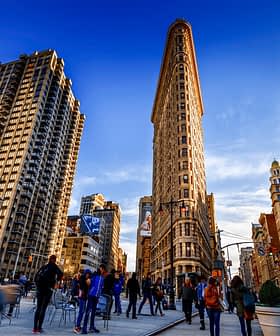Effective October 24, 2010, the United States has new Standards for Grades of Olive Oil and Olive-Pomace Oil. This is a revision of standards that have been in place since 1948. There is a lot of uncertainty over what these standards will mean for olive oil in the US. Some of the implications of the new standards are not entirely clear, but here we will try to answer the most common questions about what is and what is not covered by these standards.
What is covered by the new US Department of Agriculture (USDA) standards?
The USDA standards define the different grades of olive oil and olive-pomace oil
using chemical and sensory parameters that are similar to those of the
International Olive Council (IOC). These standards are for:
- US Extra Virgin Olive Oil
- US Virgin Olive Oil
- US Virgin Olive Oil Not Fit For Human Consumption Without Further Processing
(sometimes designated as US Lampante Virgin Olive Oil) - US Olive Oil
- US Refined Olive Oil
- US Olive-Pomace Oil
- US Refined Olive-Pomace Oil
- US Crude Olive-Pomace Oil
You can download the new USDA standard in its entirety here: Standards for Grades of Olive Oil and Olive-Pomace Oil
The USDA standards are voluntary, and cover the terms “US Extra Virgin,” etc. This means that producers may choose to seek certification by the USDA as “US Extra Virgin Olive Oil” if they wish, but that it is not mandatory.
Does this mean there will be no impact on olive oils that do not choose to use the “U.S.” grade designations?
That remains to be seen. The USDA is not an enforcement agency; it defines standards, and it serves as an inspection agency. It is the Food and Drug Administration (FDA) that actually does the regulation. The Federal Register puts it this way:
“The [olive oil standards] revision will facilitate the marketing of olive oil and olive-pomace oil, employ terms consistent with the marketplace, provide definitions for olive oil and olive-pomace oil, promote truth in labeling, and provide a basis for enforcement by State and Federal agencies if these products are mislabeled.”
(Federal Register / Vol. 75, No. 81 / Weds. April 28, 2010 / Notices)
The key phrase here is “truth in labeling.” Truth in labeling issues fall under the purview of the FDA. Allegations of truth in labeling violations are a likely place for the next chapter to start. Now that we have a US standard for “extra virgin olive oil,” there is a strong case to be made that anyone calling themselves “extra virgin olive oil” should meet that standard or they are using misleading labeling language. The next year will be an interesting one as the impact of the new standard is tested in the marketplace and, possibly, in the courts.
If they are not mandatory, what is the point of having USDA standards?
The existence of the USDA standards is a critical first step to enforcing some meaningful quality standards in this country. There is also the possibility that private entities, such as supermarket chains, and public entities, such as school lunch programs, will require USDA certification for all the olive oil they purchase. That would have an enormous impact. There is also a possible market advantage to having the USDA grade shield on your product. If consumers learn to look for that certification as their guarantee of quality in olive oil, then it could confer an edge in the marketplace, as in years past when the USDA grade shield was something people looked for on canned goods or meat, for example, or the way the USDA Organic shield serves today.
How does the USDA certification process work?
In order to be certified as US Extra Virgin Olive Oil, the product must be inspected by the USDA. This means that a USDA inspector will pull samples according to a statistically designed protocol and submit them for analysis. The standard requires that the product that is sampled and certified is verifiably the same product that is sold as such. This means that one sample cannot be tested and the determined grade regarded as covering the entire production of that year. If a tank of oil is inspected and graded, it is only that tank of oil that can bear the USDA grade. Because of the perishable nature of olive oil, there is also likely to be some protocol providing for updating of an inspection. The details of how this would function are to be determined. The inspector will submit samples to a selected lab, but simultaneously, samples will be sent to the USDA laboratory in Blakely, Georgia. The chemical requirements, and explanations of the different tests, are in the Standards for Grades of Olive Oil and Olive-Pomace Oil Appendix. The standard calls for sensory evaluation as well as the chemical analysis.
Who will do the sensory analysis?
The USDA lab in Blakely, Georgia is establishing an olive oil taste panel using the IOC protocols. The IOC protocols and recognition process are described here: International Olive Council (IOC) Olive Oil Sensory Evaluation Methodology (PDF). The USDA has staff people with experience in sensory analysis of various products. According to the USDA, the sensory panel at Blakely will be trained and capable of analyzing samples when the standard goes into effect on Oct. 25, 2010.
How do other countries handle the enforcement of olive oil standards?
The IOC defines the standard but does not do any enforcement. In fact, the IOC cannot require a member nation to enforce the standard; the burden of enforcement lies entirely with the government of the member nation or its designated regional authority. The IOC can make agreements with groups as well as nations; for example the IOC has an agreement with the North American Olive Oil Association (NAOOA) to analyze oils in IOC-recognized labs (they do not do sensory analysis for the NAOOA).
The case of enforcement in Spain (home of the IOC) is fairly typical: inspectors from a regional authority purchase random samples of olive oil from supermarket shelves. These samples are sent to an official food lab belonging to that regional authority. Sensory evaluation is not being done by all the regions, but there is a final arbiter in the form of a Spanish government food lab taste panel in Madrid. A producer can ask for triplicate analysis in the event of a controversy.
In Spain and elsewhere, notably Germany and Australia, some supermarket chains are testing olive oils for compliance with standards. This “gatekeeper” approach takes the onus off the government regulators and puts it on the producer: in order to sell to that market chain, you must prove that your oil meets the applicable standard. If you don’t wish to do so, that’s fine, but you won’t be able to sell your oil to that supermarket chain.
I am a California producer of extra virgin olive oil; what do I need to do?
If you would like to receive US Extra Virgin Olive Oil certification, contact the USDA Processed Products Branch at (202) 720‑5021. The cost for certification is estimated to be about $2000 per lot. The states of California, Oregon and Connecticut already have legal standards in place defining “extra virgin.” There is no formal mechanism in place for enforcement of the California standard, but in order to comply with that California standard, you should be sure that your olive oil is really extra virgin if you are going to call it that. There are a number of labs in the US that test olive oil on a fee-for-service basis. These include the USDA lab in Blakely, Georgia, as well as private laboratories. A list of labs is available here: US Extra Virgin Olive Oil certification labs (PDF).
Is there an IOC-recognized taste panel that will evaluate my oil?
Currently, there are no IOC-recognized olive oil taste panels in the US. IOC recognition is given only to unbiased government-sponsored taste panels that abide by the IOC taste panel regulations and pass a series of exams called “ring tests” that measure a panel’s acuity and consistency. The USDA taste panel will be eligible for IOC-recognition if they can pass the ring tests and other requirements. A number of IOC-recognized olive oil taste panels will do fee-for-service testing. A list of those panels with notes of the prices they charge can be downloaded here: International Olive Council recognized olive oil taste panels (PDF). The UC Davis Olive Oil Sensory Panel plans to seek recognition from the IOC and will provide fee-for-service sensory analysis and information about whether the oil complies with extra virgin standards. The Olive Center website will have updated information on the panel’s progress.
How do other certifications work?
There are a number of different certification schemes in place for olive oil. Most of these programs are voluntary and do not provide a legal certification of the market grade of the oil, but rather a promotional evaluation of the oil for their target market. The following is a sampling of the programs:
In Europe and other IOC member countries, the IOC standard for olive oil is in effect. There is no “certification” requirement per se; the producer may or may not have their oil tested before putting it into the marketplace. The IOC standard is enforced by each country or region, usually by spot checking, so the words “extra virgin” on a bottle have to be true. There is also a system of certification for specific geographic designations of origin that guarantee an oil as being from a particular region, typical of that region, and meeting their specific quality standards. These are referred to as DOP, DO, DOC, GDO, etc., depending on the country and designation, but all use the same blue and yellow seal. This means that the oil is made from a particular variety or varieties, grown in a designated region, and that it is harvested and milled to a specific style that is typical of that region. The European Union has a seal that appears on the labels of protected designation products.
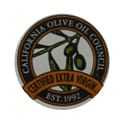 In California, the California Olive Oil Council (COOC) has a seal program that grants members a “COOC Certified Extra Virgin” seal for California-produced olive oil that meets the COOC standard for chemical analysis and is found free of defects by the COOC taste panel. Their 0.5% standard for free fatty acids is more stringent than the IOC’s 0.8% standard. Details of their certification program are available here: California Olive Oil Council olive oil certification
In California, the California Olive Oil Council (COOC) has a seal program that grants members a “COOC Certified Extra Virgin” seal for California-produced olive oil that meets the COOC standard for chemical analysis and is found free of defects by the COOC taste panel. Their 0.5% standard for free fatty acids is more stringent than the IOC’s 0.8% standard. Details of their certification program are available here: California Olive Oil Council olive oil certification
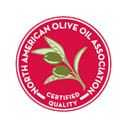 The North American Olive Oil Association (NAOOA) has a quality seal program for its members. The NAOOA Certified Quality seal is awarded to imported products that meet the IOC standards as determined by an IOC-accredited laboratory. The seal may be used on virgin and refined olive oils, but not olive-pomace oil. In the case of extra virgin grade oils, the NAOOA seal requires sensory analysis by an IOC-recognized panel. Detailed information about the NAOOA seal program is available on the NAOOA website: North American Olive Oil Association olive oil quality seal program
The North American Olive Oil Association (NAOOA) has a quality seal program for its members. The NAOOA Certified Quality seal is awarded to imported products that meet the IOC standards as determined by an IOC-accredited laboratory. The seal may be used on virgin and refined olive oils, but not olive-pomace oil. In the case of extra virgin grade oils, the NAOOA seal requires sensory analysis by an IOC-recognized panel. Detailed information about the NAOOA seal program is available on the NAOOA website: North American Olive Oil Association olive oil quality seal program
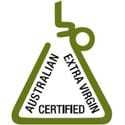 The Australian Olive Association, Ltd (AOA) has an “Australian Certified Extra Virgin” seal. This seal is only found on AOA member olive oils produced in Australia. In order to receive the seal, a producer must sign a Code of Practices that addresses olive oil quality, food safety, ethical marketing, environmental standards and other issues. The oil must meet most of the same chemical standards as the IOC, and be certified free from sensory defects and possessing some olive fruitiness by three AOA-accredited tasters. The AOA program includes labeling guidelines, and parameters for the use of rancimat testing and “use by” dates. The entire code of practices is available on the AOA site: Australian Olive Association Code of Practices
The Australian Olive Association, Ltd (AOA) has an “Australian Certified Extra Virgin” seal. This seal is only found on AOA member olive oils produced in Australia. In order to receive the seal, a producer must sign a Code of Practices that addresses olive oil quality, food safety, ethical marketing, environmental standards and other issues. The oil must meet most of the same chemical standards as the IOC, and be certified free from sensory defects and possessing some olive fruitiness by three AOA-accredited tasters. The AOA program includes labeling guidelines, and parameters for the use of rancimat testing and “use by” dates. The entire code of practices is available on the AOA site: Australian Olive Association Code of Practices
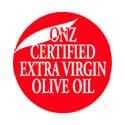 The Olives New Zealand (ONZ) certification program is open to non-members as well as members. It includes bottling and labeling standards as well as chemical and sensory criteria. The ONZ certification requires that the oil be bottled in dark glass, or if in clear glass that it be in a box or other light-excluding package. They also require a pressing date. The sensory requirements are the same as the IOC: no defects and some olive fruitiness. The ONZ program is described here: Olives New Zealand (ONZ) Certification Program
The Olives New Zealand (ONZ) certification program is open to non-members as well as members. It includes bottling and labeling standards as well as chemical and sensory criteria. The ONZ certification requires that the oil be bottled in dark glass, or if in clear glass that it be in a box or other light-excluding package. They also require a pressing date. The sensory requirements are the same as the IOC: no defects and some olive fruitiness. The ONZ program is described here: Olives New Zealand (ONZ) Certification Program
 The international group, Association 3E, certifies oils in Italy, Spain, Greece and California as “super-premium,” a higher standard than “extra virgin.” In addition to the absence of sensory defects, the oil must be evaluated for positive attributes by a designated panel. The producer must sign a code of practice that requires traceability and transparency of the volume of the oil certified and sold under that certification, as well as the quality of the product.
The international group, Association 3E, certifies oils in Italy, Spain, Greece and California as “super-premium,” a higher standard than “extra virgin.” In addition to the absence of sensory defects, the oil must be evaluated for positive attributes by a designated panel. The producer must sign a code of practice that requires traceability and transparency of the volume of the oil certified and sold under that certification, as well as the quality of the product.








